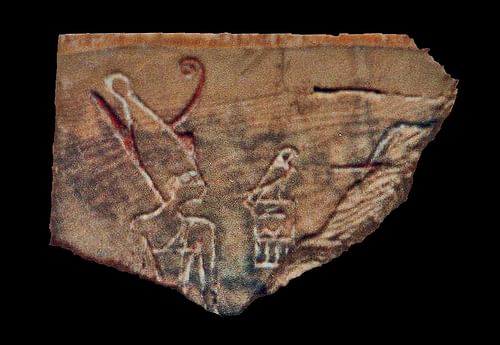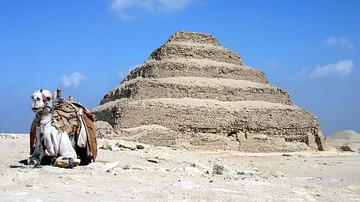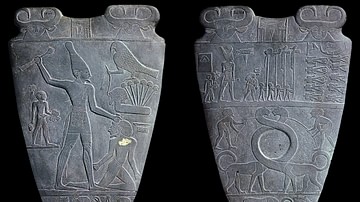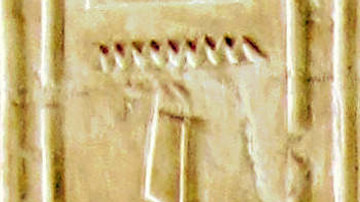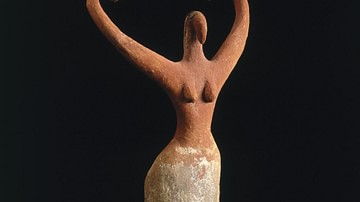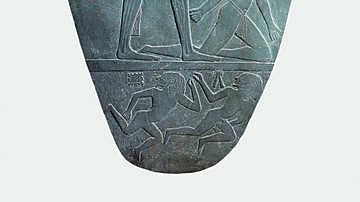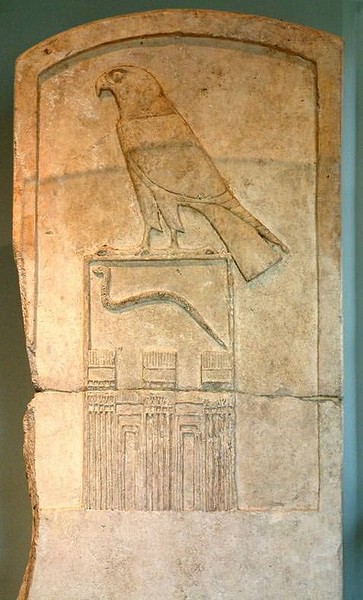
The kings of the First Dynasty of Egypt (c. 3150 - c. 2890 BCE) all worked toward the same ends: increasing trade, expansion of the kingdom through military campaigns, engaging in building projects (such as monuments, tombs, and temples), and securing central rule of the country. They ruled from the city of Thinis, near Abydos, and from Memphis. The first king, according to Manetho's chronology, was Menes who has come to be identified with the pharaoh once thought to be his successor, Narmer. Narmer united the regions of Upper Egypt and Lower Egypt under central rule initially at Thinis before then building a palace at Memphis and shifting the seat of government to that city. Historian Margaret Bunson writes:
The 1st Dynasty, begun at Memphis by Menes, was marked by significant cultural achievements. He cemented his claims to the throne [by marriage] and by instituting, or reinforcing, the previous modes of governmental and religious traditions that would become unique aspects of Egypt's heritage. Papyrus, writing, and a calendar were in use, and linear measurements, mathematics, and astronomy were practiced. A census, tax assessments, the reestablishment of boundaries after the yearly Nile inundations, and the development of new astronomical instruments moved the nation to new heights (77).
Narmer's queen, Neithhotep, may have been the first female ruler in Egypt after his death. The kings who followed Narmer all continued his policies. The greatest of these was Den (c. 2990 BCE) who is the first monarch depicted wearing the crown of Upper and Lower Egypt, indicating his dominance over the whole region. Den's mother was Merneith who may have ruled as regent when he was young or may have reigned over Egypt as Neithhotep possibly did earlier. Military campaigns were launched against Nubia, Libya, and Sinai during the First Dynasty which resulted in greater wealth and expanded territory for Egypt and those borderlands not firmly defended were annexed.
The kings of the First Dynasty were, for the most part, very effective rulers. Only Anedjib and Semerkhet are recorded as having troubled reigns. Under the rule of the pharaohs, Egypt grew from a largely agrarian culture to an increasingly urbanized state. The Egyptians seem to have been careful, however, to avoid the pitfalls of urbanization which characterized Mesopotamian cities such as overpopulation and overuse of land and water resources.
The following list of First Dynasty kings is based on Manetho's chronology, the Turin King List, and archaeological evidence as given in the scholarly work Ancient Egypt: Foundations of a Civilization by Douglas J. Brewer. The dates of the reigns are approximate. Each pharaoh built upon what had been established by their predecessor and worked to preserve the principle of ma'at (harmony) in the land. Owing to their unity of vision, and a lack of written records, it is difficult to precisely date their reigns. Exact dating is further complicated by a new model of reading ancient inscriptions (such as the Narmer Palette) symbolically rather than literally. Whereas, in the early 20th century CE, a piece like the Narmer Palette was read as history, it is now interpreted as representing cultural values of the period. While there is certainly some logic and method to this new approach, it makes precise dating nearly impossible.
Narmer (also known as Menes, c. 3150 BCE) Unified Upper and Lower Egypt and established a central government at Thinis (possibly his home city though he is also associated with Hierakonpolis) which then moved to Abydos and then Memphis. He married the princess Neithhotep of Naqada to solidify his rule and ally himself with Naqada's ruling house. Religious practices were developed and large building projects were initiated. Narmer also most likely led military expeditions to put down rebellions in Lower Egypt and to expand the territories into Nubia and Canaan. After his death, it is possible that Neithhotep reigned under her own authority. If so, she would be the first female ruler of Egypt and among the first in history, pre-dating early regents such as Sammu-Ramat of Assyria.
Hor-Aha (c. 3100 - 3050 BCE; Greek name: Athotis) was most likely the son of Narmer and Neithhotep (though he has been associated with Menes/Narmer himself). He continued his father's policies of military campaigns in Nubia but seems to have neglected Canaan. Archaeological evidence from his time indicates he was primarily interested in religious rites and building the type of tomb known as a Mastaba (Arabic for "bench") which was a precursor to the pyramids. The necropolis of Memphis dates to his reign.
Djer (c. 3050 - 3000 BCE; Greek name: Uenephes), probably the son of Hor-Aha, concerned himself largely with building palaces and military expansion. He extended his rule through military campaigns in Nubia and Canaan and used the resources gained in his building projects. Trade and industry grew under his reign.
Djet (c. 3000 - 2990 BCE; Greek name: Usaphais) was probably the son of Djer, but nothing is known of his reign. He was buried at Abydos. He was succeeded by his wife, Queen Merneith.
Merneith (c. 2990 BCE) was the wife of Djet and mother of his successor Den. There is no doubt she ruled as regent when Den was still a child but may have ruled on her own and by her own authority. Manetho does not mention her in his chronology but artifacts found in her tomb at Abydos indicate she was queen of Egypt. Her influence seems to have continued into her son's reign so, even if she did not rule in her own right, she certainly exercised power over the throne.
Den (c. 2990 - 2940 BCE; Greek name: Kenkenes) was the son of Djet and Merneith. He is the first king depicted wearing the crown of both Upper and Lower Egypt. He ruled Egypt for 50 years (though part of that reign could have been under Merneith) and enlarged the country through military conquests in Sinai. Temple complexes and elaborate tombs were built under his reign and trade flourished. The Cult of Apis (also known as Hapi), the intermediary bull-deity between humans and gods, was introduced during his reign. He is considered the greatest king of the First Dynasty.
Anedjib (c. 2940 - 2930 BCE; Greek name: Miebidos) was possibly Den's son but most likely his son-in-law. His reign was characterized by rebellion and little else is known of him.
Semerkhet (c. 2930 - 2920 BCE; Greek name: Semempses) was considered a usurper by archaeologists and scholars for many years based upon his alleged desecration of Anedjib's name on various artifacts. This theory has been discredited with the discovery of the Cairo Stone which records his legitimate reign and his tomb. He seems to have had as difficult a time as Anedjib in controlling his kingdom
Qa'a (c. 2920 - 2890 BCE; Greek name: Beieneches) was the last ruler of the First Dynasty. Very little is known about his reign except that it was very prosperous and lasted between 26 and 34 years. He was a relative of Semerkhet, probably his son. Either he had no children of his own or his sons fought over the throne since, after his death, war broke out for succession between a prince named Sneferka and another named Horus Bird. Their conflict was resolved by another prince known as Hotepsekhemwy - who either defeated them or reconciled them or both - and who then went on to found the Second Dynasty.
